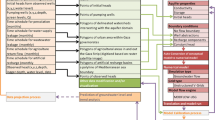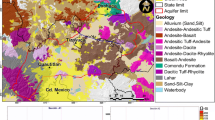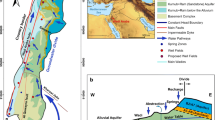Abstract
Groundwater level changes, mostly depletion, are widespread around the world due to the high population and industrial growth. Numerical models can provide relevant information in a data scares location and thus could be great means to save both money and time. In this study, an attempt was made to analyze changes in the groundwater level using the widely accepted MODFLOW-2005 model. This study covered 22 wards among the 41 wards of Chittagong city in Bangladesh and the simulation was run for the year 2009–2016. Compare to the observed water heads, the simulated model could reasonably predict water heads with a residual of less than 10%. From 2009 to 2016, the model outcome showed a depletion rate of about 4.75 m/year in the central part of the city. Finally, the model was run for the year 2020 to predict the future condition of the water head. From this, there are five wards in the central part facing a serious groundwater lowering problem. Thus, to save this natural resource more comprehensive strategies as well as ground extraction regulations should be made. And in this context, this study will provide an overview of this urgent issue in this city.
Graphic abstract











Similar content being viewed by others
References
Aeschbach-Hertig W, Gleeson T (2012) Regional strategies for the accelerating global problem of groundwater depletion. Nature Geosci 5(12):853–861. https://doi.org/10.1038/ngeo1617
Ahlfeld DP, Barlow PM, Mulligan AE (2005) GWM—A ground-water management process for the U.S. Geological Survey modular ground-water model (MODFLOW-2000): U.S. Geological Survey Open-File Report 2005–1072, p. 124
Bastani M, Kholghi M, Rakhshandehroo GR (2010) Inverse modeling of variable-density groundwater flow in a semi-arid area in Iran using a genetic algorithm. Hydrogeol J 18(5):1191–1203
Bosompemaa P, Yidana SM, Chegbeleh LP (2016) Analysis of transient groundwater flow through a stochastic modelling approach. Arab J Geosci 9(17):1–14
Chiang WH, Kinzelbach W (1998) Processing modflow. A simulation program for modelling groundwater flow and pollution. Guide for the program. p. 334
CWASA (2014) Hydrogeological report. Chittagong Water Supply & Sewerage Authority (CWASA). Preparatory survey on the Chittagong Water supply improvment project in the people's republic of bangladesh
DHI (2014) Mike she. vol: 1. Available on: https://www.mikepoweredbydhi.com. Accessed 20 Mar 2015
Diersch Hans-Jörg G (2014) FEFLOW – Finite element modeling of flow, mass and heat transport in porous and fractured media, Springer, Berlin Heidelberg, XXXV, 996p., ISBN 978–3–642–38738–8, ISBN 978–3–642–38739–5 (eBook), https://doi.org/10.1007/978-3-642-38739-5
Döll P, Hoffmann-Dobrev H, Portmann FT, Siebert S, Eicker A, Rodell M, Strassberg G, Scanlon BR (2012) Impact of water withdrawals from groundwater and surface water on continental water storage variations. J Geodyn 59–60, pp.143–156. Available at: https://www.sciencedirect.com/science/article/pii/S0264370711000597
Don NC, Araki H, Yamanishi H, Koga K (2004) Simulation of groundwater flow and environmental effects resulting from pumping. Environ Geol 47(3):361–374. https://doi.org/10.1007/s00254-004-1158-1
Freeze RA, Witherspoon PA (1966) Theoretical analysis of regional groundwater flow: 1. analytical and numerical solutions to the mathematical model. Water Resour Res 2(4):641–656
Gingerich SB, Voss CI (2005) Three-dimensional variable-density flow simulation of a coastal aquifer in southern Oahu. Hawaii, USA
Gleeson T, Wada Y, Bierkens MFP, van Beek LPH (2012) Water balance of global aquifers revealed by groundwater footprint. Nature 488(7410):197–200. https://doi.org/10.1038/nature11295
Gorantiwar SD, Krishnamoorthy YVN, Pandit DS, Joshi AK, Das S (2015) The effect of changing climate and land use/land cover on water resources in hard rock region of Maharashtra State. In Climate Change Modelling, Planning and Policy for Agriculture (pp. 199–217). Springer, New Delhi
Gusyev MA, Abrams D, Toews MW, Morgenstern U, Stewart MK (2014) A comparison of particle-tracking and solute transport methods for simulation of tritium concentrations and groundwater transit times in river water. Hydrol Earth Syst Sci 18(8):3109–3119
Harbaugh BAW et al (2000) MODFLOW-2000 , The U.S. geological survey modular ground-water model — user guide to modularization concepts and the ground-water flow process U. S. geological survey open-file report 00-92
Harbaugh AW (2005) MODFLOW-2005, the U.S. Geological Survey modular ground-water model – the Ground-Water Flow Process: U.S. Geological Survey Techniques and Methods 6–A16
Heywood CE, Pope JP (2009) Simulation of groundwater flow in the Coastal Plain aquifer system of Virginia. U.S. Geological Survey Scientific Investigations Report 2009–5039, p 115
Hossain S, Bashar K, Ahmed N (2008) An Approach to hydrological zonation: a case study for the Chittagong city. Bangladesh Geosci J 14:33–35
Huo ZL, Feng SY, Kang SZ, Cen SJ, Ma Y (2007) Simulation of effects of agricultural activities on groundwater level by combining FEFLOW and GIS. N Z J Agricul Res 50(5):839–846
Jayatilaka CJ, Storm B, Mudgway LB (1998) Simulation of water flow on irrigation bay scale with MIKE-SHE. J Hydrol 208(1-2/2):108–130
Khadri SFR, Pande C (2016) Ground water flow modeling for calibrating steady state using MODFLOW software: a case study of Mahesh River basin, India. Model Earth Syst Environ. https://doi.org/10.1007/s40808-015-0049-7
Krause S, Bronstert A, Zehe E (2007) Groundwater-surface water interactions in a North German lowland floodplain—implications for the river discharge dynamics and riparian water balance. J Hydrol 347:404–417. https://doi.org/10.1016/j.jhydrol.2007.09.028
Konikow LF (2011) Contribution of global groundwater depletion since 1900 to sea-level rise. Geophys Res Lett. https://doi.org/10.1029/2011GL048604
Langevin CD, Thorne Jr DT, Dausman AM, Sukop MC, Guo W (2007) SEAWAT Version 4: A computer program for simulation of multi-species solute and heat transport. U.S. Geological Survey Techniques and Methods Book 6, p. 39
Lavigne M-A, Nastev M, Lefebvre R (2010) Numerical simulation of groundwater flow in the chateauguay river aquifers. Canadian Water Resour J 35(4):469–486
Leduc C (2005) Orsay hydrogeological modeling. Written notes on numerical modeling in hydrogeology: 16 Modélisation hydrogéologique Orsay 2004 – 2005. Notes de cours de modélisation numérique en hydrogéologique, Université de Paris-Sud, Paris. pp 16
Liu HL, Bao AM, Pan XL, Chen X (2013) Effect of land-use change and artificial recharge on the groundwater in an arid inland river basin. Water Resour Manage 27(10):3775–3790
Ma Z, Fang Z, Xie X, Chai F, Zhang Q (2015) Study on feature storage and storage capacity of underground reservoir based on GMS in MHS area of Beijing China. Arab J Geosci 8(12):10359–10369
Nyende J, TG V, (2013) Conceptual and numerical model development for groundwater resources management in a regolith-fractured-basement aquifer system. J Earth Sci Climatic Change 4(5):156
Owen SJ, Jones NL, Holland JP (1996) A Comprehensive modeling environment for the simulation of groundwater flow and transport. Engh Comp 12:235–242
Pokhrel YN, Hanasaki N, Yeh PJF, Yamada TJ, Kanae S, Oki T (2012) Model estimates of sea-level change due to anthropogenic impacts on terrestrial water storage. Nature Geosci 5(6):389–392. https://doi.org/10.1038/ngeo1476
Rahnama MB, Zamzam A (2013) Quantitative and qualitative simulation of groundwater by mathematical models in Rafsanjan aquifer using MODFLOW and MT3DMS. Arab J Geosci 6(3):901–912
Shi W, Zeng W, Chen B (2010) Application of visual MODFLOW to assess the sewage plant accident pool leakage impact on groundwater in the Guanting reservoir area of Beijing. Front Earth Sci China 4(3):320–325
Sun RJ, Johnston RH (1994) Regional aquifer - system analysis program of the U. S. geological survey, 1978–1992. U.S. Geolog Survey Circular 1099:1978–1992
Toth J (1970) A conceptual model of the groundwater regime and the hydrogeologic environment. J Hydrol 10:164–176
USGS (1978) Regional aquifer-system analysis (rasa) program
Voss CI, Provost AM (2002) SUTRA, A model for saturated-unsaturated variable-density ground-water flow with solute or energy transport, U.S. Geological Survey Water-Resources Investigations Report 02-4231, 250 p
Wada Y, van Beek LPH, van Kempen CM, Reckman JWTM, Vasak S, Bierkens MFP (2010) Global depletion of groundwater resources. Geophys Res Lett. https://doi.org/10.1029/2010GL044571
Wang S, Shao J, Song X, Zhang Y, Huo Z, Zhou X et al (2008) Application of MODFLOW and geographic information system to groundwater flow simulation in North China Plain China. Environ Geol 55(7):1449–1462
Wels C, Mackie D, Scibek J (2012) British Columbia Ministry of Environment Groundwater Modelling Guidelines. 194001. Prepared by British Columbia Ministry of Environment, Water Protection and Sustainability Branch: Vancouver, BC
Williamson AK, Predic DE, Swain L.A.C.N.-0000 (1989) Ground-water flow in the Central Valley, California: U.S. Geological Survey Professional Paper 1401-D, p 127
Wydawnictwo D (2005) MODELING of flow and transport in porous media using FEFLOW
Yousafzai A, Eckstein Y, Dahl P (2008) Numerical simulation of groundwater flow in the Peshawar intermontane basin, northwest Himalayas. Hydrogeol J 16(7):1395–1409. https://doi.org/10.1007/s10040-008-0355-5
Zheng BC, Wang PP (1999) A modular three - dimensional multispecies transport model for simulation of advection, dispersion, and chemical reactions of contaminants in groundwater systems; documentation and user's guide," Contract Report SERDP-99-1, U.S. Army Engineer Research and Development Center, Vicksburg, MS
Zhou Y, Li W (2011) A review of regional groundwater flow modeling. Geoscience Frontiers 2(2):205-214
Zimmerman RD, Murillo-Sánchez CE (2019). MATPOWER User's Manual (Version 7.0). Zenodo. https://doi.org/10.5281/zenodo.3251118
Acknowledgements
This study has been carried out in the Department of Civil Engineering, Chittagong University of Engineering and Technology (CUET), Bangladesh. Funding for this work was provided by the University Grants Commission (UGC) of Bangladesh for a research project Modeling of Groundwater Lowering in Chittagong (MGLC), and additional support from the Department of Civil Engineering in CUET, CWASA, CDA, and BWDB, are gratefully acknowledged.
Author information
Authors and Affiliations
Corresponding author
Additional information
Publisher's Note
Springer Nature remains neutral with regard to jurisdictional claims in published maps and institutional affiliations.
Rights and permissions
About this article
Cite this article
Akter, A., Ahmed, S. Modeling of groundwater level changes in an urban area. Sustain. Water Resour. Manag. 7, 7 (2021). https://doi.org/10.1007/s40899-020-00480-x
Received:
Accepted:
Published:
DOI: https://doi.org/10.1007/s40899-020-00480-x




